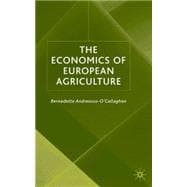
| List of Figures | xi | ||||
| List of Tables | xiii | ||||
| Acknowledgements | xvi | ||||
| Introduction | 1 | (3) | |||
| 1 Concepts and Definitions | 4 | (37) | |||
|
4 | (1) | |||
|
4 | (6) | |||
|
10 | (13) | |||
|
23 | (14) | |||
|
37 | (1) | |||
|
37 | (1) | |||
|
38 | (1) | |||
|
38 | (3) | |||
| 2 Demand and Supply - Market Mechanisms for Agricultural Products | 41 | (24) | |||
|
41 | (1) | |||
|
41 | (1) | |||
|
42 | (4) | |||
|
46 | (5) | |||
|
51 | (9) | |||
|
60 | (1) | |||
|
61 | (1) | |||
|
62 | (1) | |||
|
62 | (1) | |||
|
63 | (2) | |||
| 3 Government Intervention in Agriculture | 65 | (24) | |||
|
65 | (1) | |||
|
65 | (1) | |||
|
66 | (1) | |||
|
67 | (9) | |||
|
76 | (10) | |||
|
86 | (1) | |||
|
87 | (1) | |||
|
87 | (1) | |||
|
88 | (1) | |||
| 4 The Common Agricultural Policy | 89 | (42) | |||
|
89 | (1) | |||
|
89 | (1) | |||
|
90 | (10) | |||
|
100 | (12) | |||
|
112 | (14) | |||
|
126 | (1) | |||
|
127 | (1) | |||
|
128 | (1) | |||
|
129 | (2) | |||
| 5 Technology and Innovation | 131 | (35) | |||
|
131 | (1) | |||
|
131 | (3) | |||
|
134 | (8) | |||
|
142 | (8) | |||
|
150 | (2) | |||
|
152 | (9) | |||
|
161 | (1) | |||
|
162 | (1) | |||
|
162 | (1) | |||
|
163 | (3) | |||
| 6 A Wider European Union: Enlargement to Central and Eastern Europe, Cyprus and Malta | 166 | (23) | |||
|
166 | (1) | |||
|
166 | (1) | |||
|
167 | (3) | |||
|
170 | (16) | |||
|
186 | (1) | |||
|
187 | (1) | |||
|
187 | (1) | |||
|
188 | (1) | |||
| 7 The EU as an Agricultural Trade Partner | 189 | (31) | |||
|
189 | (1) | |||
|
189 | (5) | |||
|
194 | (4) | |||
|
198 | (13) | |||
|
211 | (4) | |||
|
215 | (1) | |||
|
216 | (1) | |||
|
217 | (1) | |||
|
218 | (2) | |||
| 8 Agricultural Trade Liberalization | 220 | (32) | |||
|
220 | (1) | |||
|
220 | (2) | |||
|
222 | (10) | |||
|
232 | (4) | |||
|
236 | (1) | |||
|
237 | (7) | |||
|
244 | (2) | |||
|
246 | (2) | |||
|
248 | (1) | |||
|
248 | (1) | |||
|
249 | (3) | |||
| Conclusions: The Future of EU and World Agriculture - The Challenges Ahead | 252 | (6) | |||
| Index | 258 |
The New copy of this book will include any supplemental materials advertised. Please check the title of the book to determine if it should include any access cards, study guides, lab manuals, CDs, etc.
The Used, Rental and eBook copies of this book are not guaranteed to include any supplemental materials. Typically, only the book itself is included. This is true even if the title states it includes any access cards, study guides, lab manuals, CDs, etc.